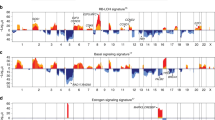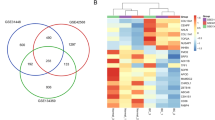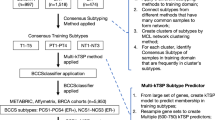Abstract
To investigate changes in gene expression associated with ERBB2, expression profiling of immortalized human mammary luminal epithelial cells and variants expressing a moderate and high level of ERBB2 has been carried out using cDNA microarrays corresponding to approximately 6000 unique genes/ESTs. A total of 61 significantly up- or downregulated (2.0-fold) genes were identified and further validated by RT–PCR analysis as well as microarray comparisons with a spontaneously ERBB2- overexpressing breast cancer cell line and ERBB2-positive primary breast tumors. The expression and clinical relevance of proteins predicted to be associated with ERBB2 overexpression in breast cancers were analysed together with their clinical relevance by antibody screening using a tissue array. Differentially regulated genes include those involved in cell–matrix interactions including proline 4-hydroxylase (P4HA2), galectin 1 (LGALS1) and galectin 3 (LGALS3), fibronectin 1 (FN1) and p-cadherin (CDH3), and cell proliferation (CRIP1, IGFBP3) and transformation (S100P, S100A4). A number of genes associated with MYC signalling were also differentially expressed, including NDRG1, USF2 and the epithelial membrane proteins 1 and 3 (EMP1, EMP3). These data represent profiles of the transcriptional changes associated with ERBB2-related pathways in the breast, and identify novel and potentially useful targets for prognosis and therapy.
This is a preview of subscription content, access via your institution
Access options
Subscribe to this journal
Receive 50 print issues and online access
$259.00 per year
only $5.18 per issue
Buy this article
- Purchase on Springer Link
- Instant access to full article PDF
Prices may be subject to local taxes which are calculated during checkout




Similar content being viewed by others
References
Andre S, Kojima S, Yamazaki N, Fink C, Kaltner H, Kayser K and Gabius, HJ . (1999). J. Cancer Res. Clin. Oncol., 125, 461–474.
Baldini A, Gress T, Patel K, Muresu R, Chiariotti L, Williamson P, Boyd Y, Casciano I, Wells V, Bruni CB, Mallucci L and Siniscalco M . (1993). Genomics, 15, 216–218.
Baselga J, Tripathy D, Mendelsohn J, Baughman S, Benz CC, Dantis L, Sklarin NT, Seidman AD, Hudis CA, Moore J, Rosen PP, Twaddell T, Henderson IC and Norton L . (1996). J. Clin. Oncol., 14, 737–744.
Ben-Porath I, Kozak CA and Benvenisty N . (1998). Genomics, 49, 443–447.
Ben-Porath I, Yanuka O and Benvenisty N . (1999). Mol. Cell. Biol., 19, 3529–3539.
Bieche I, Tomasetto C, Regnier CH, Moog-Lutz C, Rio MC and Lidereau R . (1996). Cancer Res., 56, 3886–3890.
Brazma A, Hingamp P, Quackenbush J, Sherlock G, Spellman P, Stoeckert C, Aach J, Ansorge W, Ball CA, Causton HC, Gaasterland T, Glenisson P, Holstege FC, Kim IF, Markowitz V, Matese JC, Parkinson H, Robinson A, Sarkans U, Schulze-Kremer S, Stewart J, Taylor R, Vilo J and Vingron M . (2001). Nat. Genet., 29, 365–371.
Chen Y, Medvedev A, Ruzanov P, Marvin KW and Jetten AM . (1997). Genomics, 41, 40–48.
Chomczynski P and Sacchi N . (1987). Anal. Biochem., 162, 156–159.
Cobleigh MA, Vogel CL, Tripathy D, Robert NJ, Scholl S, Fehrenbacher L, Wolter JM, Paton V, Shak S, Lieberman G and Slamon DJ . (1999). J. Clin. Oncol., 17, 2639–2648.
Cuny M, Kramar A, Courjal F, Johannsdottir V, Iacopetta B, Fontaine H, Grenier J, Culine S and Theillet C . (2000). Cancer Res., 60, 1077–1083.
De Iorio P, Midulla C, Pisani T, Valli C, Grillo L, Di Cocco B, Nofroni I and Vecchione A . (2001). Anticancer Res., 21, 1395–1399.
Gamallo C, Moreno-Bueno G, Sarrio D, Calero F, Hardisson D and Palacios J . (2001). Mod. Pathol., 14, 650–654.
Goldstone SD and Lavin MF . (1991). Biochem. Biophys. Res. Commun., 178, 746–750.
Guerreiro Da Silva ID, Hu YF, Russo IH, Ao X, Salicioni AM, Yang X and Russo J . (2000). Int. J. Oncol., 16, 231–240.
Harris RA, Eichholtz TJ, Hiles ID, Page MJ and O'Hare MJ . (1999). Int. J. Cancer, 80, 477–484.
Hippo Y, Yashiro M, Ishii M, Taniguchi H, Tsutsumi S, Hirakawa K, Kodama T and Aburatani H . (2001). Cancer Res., 61, 889–895.
Houston SJ, Plunkett TA, Barnes DM, Smith P, Rubens RD and Miles DW . (1999). Br. J. Cancer, 79, 1220–1226.
Hughes RC . (2001). Biochimie, 83, 667–676.
Ignatoski KM, Maehama T, Markwart SM, Dixon JE, Livant DL and Ethier SP . (2000). Br. J. Cancer, 82, 666–674.
Kauraniemi P, Bärlund M, Monni O, Kallioniemi A . (2001). Cancer Res., 61, 8235–8240.
Kononen J, Bubendorf L, Kallioniemi A, Barlund M, Schraml P, Leighton S, Torhorst J, Mihatsch MJ, Sauter G and Kallioniemi OP . (1998). Nat. Med., 4, 844–847.
Liehr T, Kuhlenbaumer G, Wulf P, Taylor V, Suter U, Van Broeckhoven C, Lupski JR, Claussen U and Rautenstrauss B . (1999). Genomics, 58, 106–108.
Lu Y, Zi X, Zhao Y, Mascarenhas D and Pollak M . (2001). J. Natl. Cancer Inst., 93, 1852–1857.
Mazzucchelli L . (2002). Am. J. Pathol., 160, 7–13.
Menard S, Fortis S, Castiglioni F, Agresti R and Balsari A . (2001). Oncology, 61, 67–72.
Miles DW, Harris WH, Gillett CE, Smith P and Barnes DM . (1999). Int. J. Cancer, 84, 354–359.
Moon BK, Lee YJ, Battle P, Jessup JM, Raz A and Kim HR . (2001). Am. J. Pathol., 159, 1055–1060.
Paz A, Haklai R, Elad-Sfadia G, Ballan E and Kloog Y . (2001). Oncogene, 20, 7486–7493.
Pegram MD, Lipton A, Hayes DF, Weber BL, Baselga JM, Tripathy D, Baly D, Baughman SA, Twaddell T, Glaspy JA and Slamon DJ . (1998). J. Clin. Oncol., 16, 2659–2671.
Peralta Soler A, Knudsen KA, Salazar H, Han AC and Keshgegian AA . (1999). Cancer, 86, 1263–1272.
Perillo NL, Marcus ME and Baum LG . (1998). J. Mol. Med., 76, 402–412.
Perou CM, Sorlie T, Eisen MB, van de Rijn M, Jeffrey SS, Rees CA, Pollack JR, Ross DT, Johnsen H, Akslen LA, Fluge O, Pergamenschikov A, Williams C, Zhu SX, Lonning PE, Borresen-Dale AL, Brown PO and Botstein D . (2000). Nature, 406, 747–752.
Rocha RL, Hilsenbeck SG, Jackson JG, Lee AV, Figueroa JA and Yee D . (1996). J. Natl. Cancer Inst., 88, 601–606.
Ross JS and Fletcher JA . (1998). Oncologist, 3, 237–252.
Ross JS and Fletcher JA . (1999). Semin. Cancer Biol., 9, 125–138.
Rudland PS, Platt-Higgins A, Renshaw C, West CR, Winstanley JH, Robertson L and Barraclough R . (2000). Cancer Res., 60, 1595–1603.
Schiemann S, Ruckels M, Engelholm LH, Schwirzke M, Brunner N and Weidle UH . (1997). Anticancer Res., 17, 13–20.
Scorilas A, Trangas T, Yotis J, Pateras C and Talieri M . (1999). Br. J. Cancer, 81, 1385–1391.
Shen L and Glazer RI . (1998). Biochem. Pharmacol., 55, 1711–1719.
Slamon DJ, Clark GM, Wong SG, Levin WJ, Ullrich A and McGuire WL . (1987). Science, 235, 177–182.
Slamon DJ, Godolphin W, Jones LA, Holt JA, Wong SG, Keith DE, Levin WJ, Stuart SG, Udove J, Ullrich A and Press MF . (1989). Science, 244, 707–712.
Slamon DJ, Leyland-Jones B, Shak S, Fuchs H, Paton V, Bajamonde A, Fleming T, Eiermann W, Wolter J, Pegram M, Baselga J and Norton L . (2001). N. Engl. J. Med., 344, 783–792.
Sorlie T, Perou CM, Tibshirani R, Aas T, Geisler S, Johnsen H, Hastie T, Eisen MB, van de Rijn M, Jeffrey SS, Thorsen T, Quist H, Matese JC, Brown PO, Botstein D, Eystein Lonning P and Borresen-Dale AL . (2001). Proc. Natl. Acad. Sci. USA, 98, 10869–10874.
Stoll BA . (1997). Br. J. Cancer, 76, 1652–1654.
Tomasetto C, Regnier C, Moog-Lutz C, Mattei MG, Chenard MP, Lidereau R, Basset P and Rio MC . (1995). Genomics, 28, 367–376.
Werbajh SE, Urtreger AJ, Puricelli LI, de Lustig ES, Bal de Kier Joffe E and Kornblihtt AR . (1998). FEBS Lett., 440, 277–281.
Yang YH, Dudoit S, Luu P, Lin DM, Peng V, Ngai J and Speed TP . (2002). Nucleic. Acids Res., 30, e15.
Yu D and Hung MC . (2000). BioEssays, 22, 673–680.
Acknowledgements
The microarray consortium is funded by the Wellcome Trust, the Imperial Cancer Research Fund and the Ludwig Institutes of Cancer Research. We thank the staff of the Sanger Institute Microarray Facility (http://www.sanger.ac.uk/Projects/Microarrays/) for the supply of arrays, lab protocols, and technical advice (David Vetrie, Cordelia Langford, Adam Whittaker, Neil Sutton), Quantarray/GeneSpring datafiles and all data analysis and databases relating to elements on the arrays (Kate Rice, Rob Andrews, Adam Butler, Harish Chudasama). The human I.M.A.G.E. cDNA clone collection was obtained from the MRC HGMP Resource Centre (Hinxton, UK). All cDNA clone resequencing was performed by Team 56 at the Sanger Institute. We are indebted to Professor Ricardo Brentani at the Hospital do Cancer A.C. Camargo, Sao Paulo, Brazil for the tumor RNA. We are grateful to Professors Munro Neville and Alan Ashworth for continued support and helpful discussions pertaining to this project. This work was supported by Breakthrough Breast Cancer.
Author information
Authors and Affiliations
Corresponding author
Rights and permissions
About this article
Cite this article
Mackay, A., Jones, C., Dexter, T. et al. cDNA microarray analysis of genes associated with ERBB2 (HER2/neu) overexpression in human mammary luminal epithelial cells. Oncogene 22, 2680–2688 (2003). https://doi.org/10.1038/sj.onc.1206349
Received:
Revised:
Accepted:
Published:
Issue Date:
DOI: https://doi.org/10.1038/sj.onc.1206349
Keywords
This article is cited by
-
Lactose on the basolateral side of mammary epithelial cells inhibits milk production concomitantly with signal transducer and activator of transcription 5 inactivation
Cell and Tissue Research (2022)
-
Persistent activation of interlinked type 2 airway epithelial gene networks in sputum-derived cells from aeroallergen-sensitized symptomatic asthmatics
Scientific Reports (2018)
-
Plasma S100P level as a novel prognostic marker of metastatic breast cancer
Breast Cancer Research and Treatment (2016)
-
Prolyl-4-hydroxylase α subunit 2 promotes breast cancer progression and metastasis by regulating collagen deposition
BMC Cancer (2014)
-
The impact of Cysteine-Rich Intestinal Protein 1 (CRIP1) in human breast cancer
Molecular Cancer (2013)



